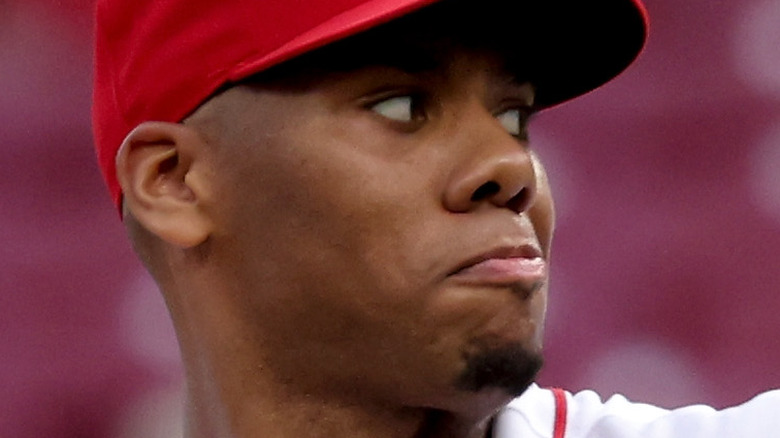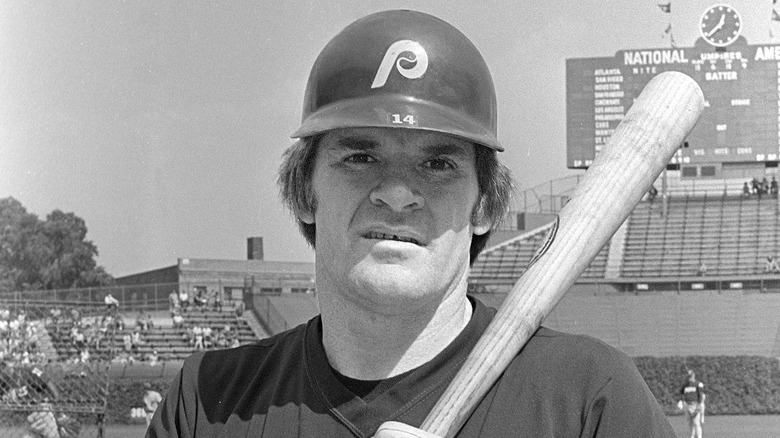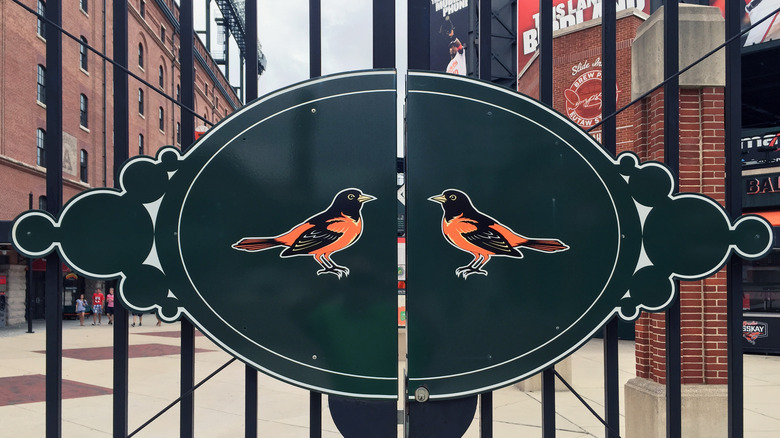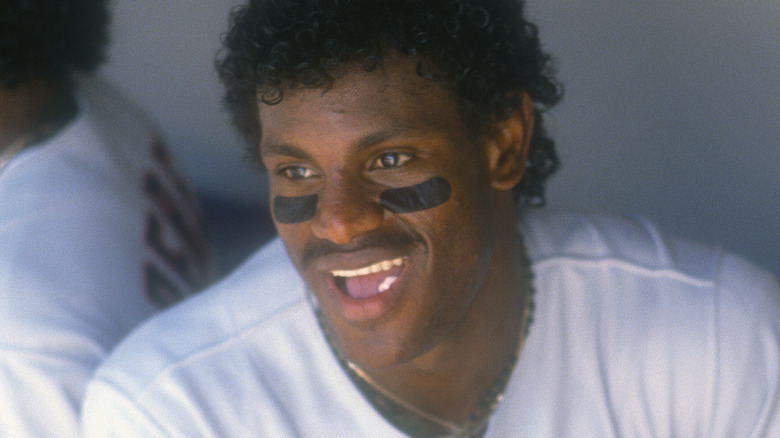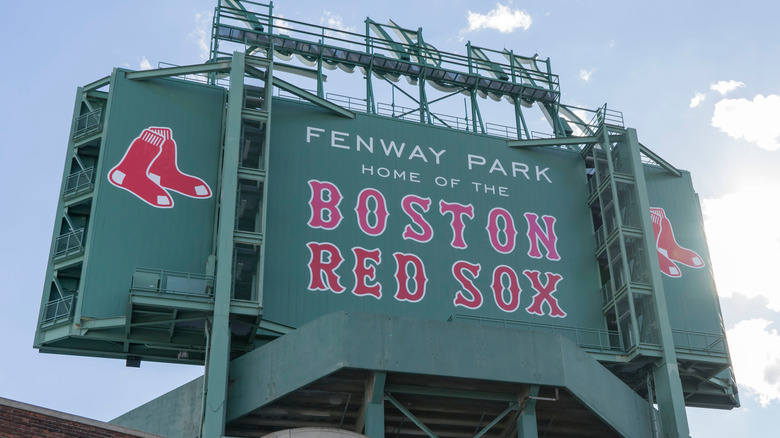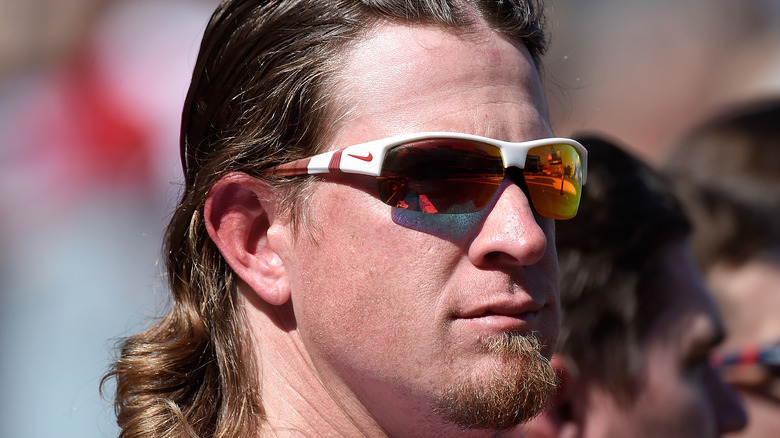How Can A Baseball Team Allow Zero Hits And Still Lose?
When in baseball is a no-hitter not a no-hitter, and how can an MLB team allow no hits at all, but still lose a game? Not to mention, how can a baseball team win a game without recording a hit? As strange as these riddles may seem, in mid-May of the 2022 MLB season, all three of those things happened in a game between the Cincinnati Reds and the Pittsburgh Pirates. To make matters even more strange, this wasn't the first time in MLB history that in-game events played out in this fashion, according to ESPN. Reds' pitcher Hunter Greene (above) started the game against the Pirates.
Of all the sports, baseball fans love unusual records and unique stats perhaps more than any other, such as catcher Roy Campanella's caught-stealing percentage, or Eddie Collins' number of sacrifice hits, to name just a few (via USA Today). Although unusual, a baseball team recording a win with no hits, while a pitcher allowing no hits although his team ends up losing, has happened six times in MLB history. The 2022 Reds-Pirates game was the first since 2008, per Sports Illustrated. Here's a look back at all six instances that this highly-unusual outcome played out on the diamond.
The first time it happened, the Reds won the game
One important distinction to clarify right up front is there are two types of no-hitters in baseball: a nine-inning no-hitter, which means one pitcher pitched the whole game without allowing a hit, and a combined no-hitter, meaning across the starters, relievers, and closers, no hits were allowed, per MLB. The first instance, when a pitcher pitched a complete no-hitter but still ended up losing, happened in 1964, between the Colt .45s (now the Houston Astros, via MLB) and the Reds, which at the time featured now-notorious MLB player and manager Pete Rose (pictured).
Ken Johnson was on the mound for the Colt .45s and was on his way to pitching a complete game no-hitter when Rose reached base on an error. The next batter grounded out, at which point Rose was able to reach third. Following that, a grounder was bobbled at second base and Rose crossed the plate. That was the only point scored in the game. Of the dubious honor of being the first pitcher in history to throw a complete no-hitter and still lose, Johnson later said (via MLB), "I pitched the best game of my life. A hell of a way to get into the record books."
It happened again only three seasons later
The next no-hitter that still resulted in a loss was nearly complete. It took place between the Baltimore Orioles and the Detroit Tigers in 1967. Baltimore seemed well on their way to winning with Steve Barber on the mound for the Birds, according to the Society for American Baseball Research. Making matters even more strange, the score headed into the ninth inning was 1–0 in the Orioles favor, but ended up 2–1, Tigers.
Barber walked two hitters in the ninth. After runners advanced on a sacrifice bunt, the Tigers tied the game on a Barber wild pitch. After one more walk, Barber was pulled from the game. A new pitcher failed to improve Baltimore's fortunes, though. A Detroit grounder and a fielding error resulted in one more score, and the game moved into the bottom of the ninth inning, 2–1. After the first three Baltimore batters went down in order, the Orioles lost.
No hits with a loss happened again in 1990
The next game that resulted in a no-hitter with a loss took place in 1990, between the New York Yankees and the Chicago White Sox. With pitcher Andy Hawkins on the mound for The Pinstripes, the score was 0–0 through the seventh when Sammy Sosa (pictured) reached base on an error in the eighth. Sosa would end up stealing second. After two walks, the bases were loaded. After a fielding error on a fly ball, all three runs scored. Robin Ventura — who hit the fly ball — ended up on second (via MLB).
At that point, another fielding error allowed Ventura to score and after New York failed to score in the ninth, the game was over 4–0 in Chicago's favor. Hawkins, who pitched a complete game allowing no-hits or earned runs, but still ended up losing, was stunned by the outcome. As he said after the game (via MLB) "I'm stunned that I threw a no-hitter, and I'm stunned that I got beat. I'll have to sleep on this."
The next example happened just two seasons later
Allowing no hits is likely not much comfort when your team loses, and it must feel like even less of an achievement when that game also comes along with seven walks. That's precisely what happened in 1992 when the Boston Red Sox faced the Cleveland Indians (now the Guardians, per MLB). In this game, pitcher Matt Young remained hitless through eight innings. Due to seven walks and a throwing error resulting in two earned runs, though, the score was 2–1 in favor of Cleveland and Young was pulled in the ninth (via MLB).
The only run Boston would score came in the fourth, and Cleveland held on to win the game, albeit without ever recording a hit. Given the accomplishment of technically throwing a no-hitter, Young found little cause for celebration because his team still lost the game, making the no-hitter distinction irrelevant. After the game, Young said (via MLB), "A no-hitter's supposed to be where you strike out the last guy and the catcher comes out and jumps in your arms. A loss is a loss."
A Dodgers and Angels game ended 1-0, despite no hits allowed
Prior to the 2022 game between the Reds and the Pirates, another game with a similar outcome took place in 2008 between two Los Angeles teams, the Angels and the Dodgers. Future three-time Cy Young Award finalist Jered Weaver (pictured) was on the mound that day for the Angels. He held the Dodgers scoreless into the fifth when a whole sequence of unusual events and bad luck befell the Angels, including an error from Weaver himself. As a result, the Dodgers scored, as MLB explains.
Jose Arredondo would relieve Weaver after six, but despite the fact Arredondo maintained Weaver's hitless streak, the Angels were unable to score and would end up losing the game. Weaver said later that he thought the game in question should not even count as a no-hitter. "I'm sure you guys are going to eat this up a lot more than I am," Weaver said, referring to sports writers and baseball statisticians (via MLB). "I don't consider it a no-hitter for me."
The 2022 Reds-Pirates game
Not technically a no-hitter, per the letter of the MLB rulebook which defines the accomplishment (via Baseball Reference), the 2022 Reds-Pirates game that resulted in no hits allowed from the Reds (yet the team still lost) saw two Reds pitchers take the mound: starter Hunter Greene and reliever Art Warren. The Pirates had two walks against Greene in the eighth. He was then pulled for Warren, who would end up walking Pirates player Ben Gamel to load the bases, as The Guardian notes.
Following that last walk, a grounder was not fielded cleanly by the Reds second basemen, and the Pirates scored. Reds batters were unable to score in the ninth and the game ended 1–0 in the Pirates' favor. Ke'Bryan Hayes (pictured), who hit what would end up to be the game-winning grounder, later said (via The Guardian), "I mean, to not even get in a hit in a game and to get a win, I'm sure that hasn't happened a lot since baseball's been going on." And as can be seen, Hayes is correct — it is a very rare occurrence indeed.
